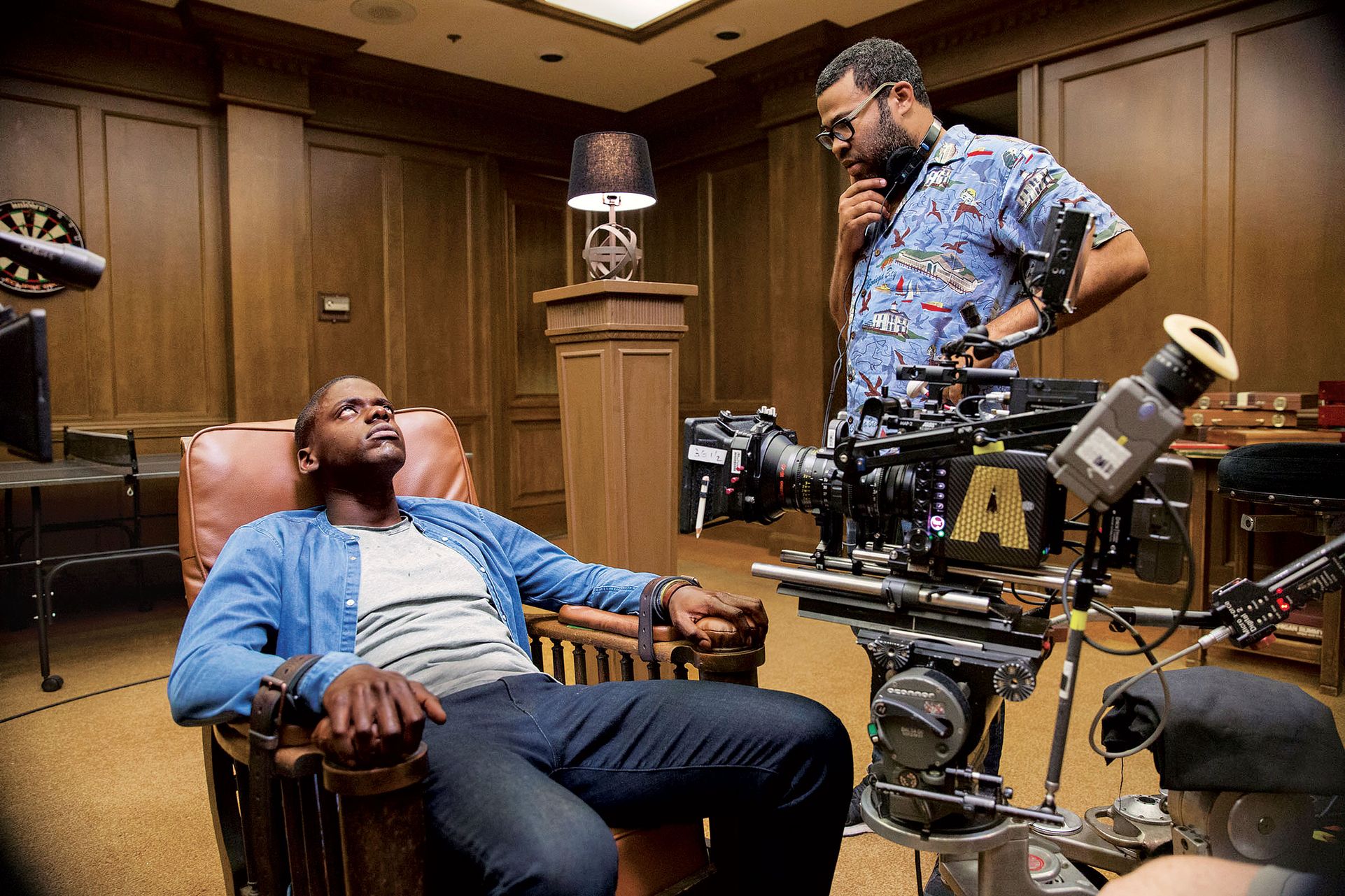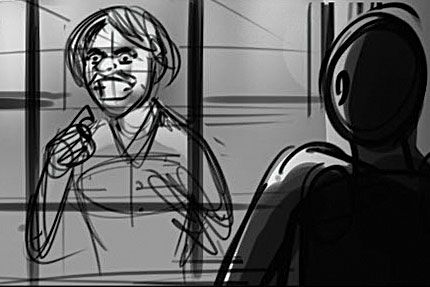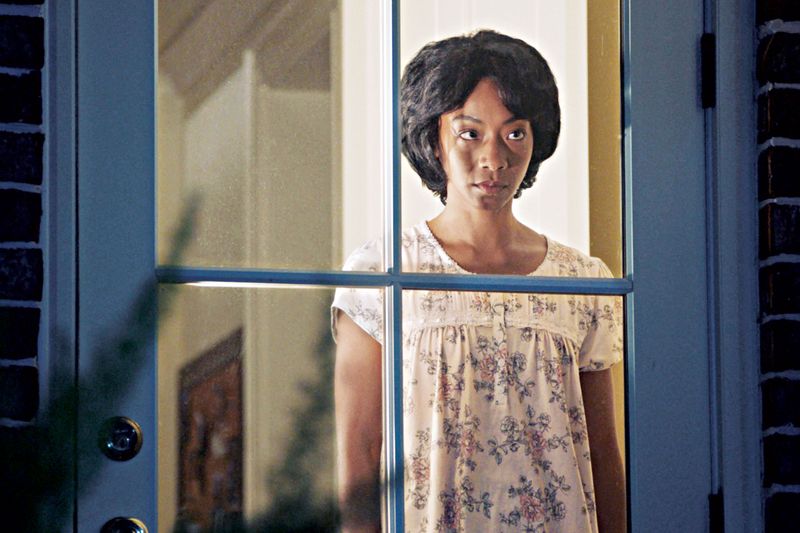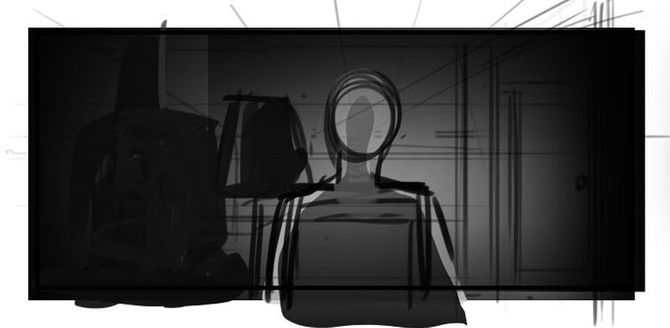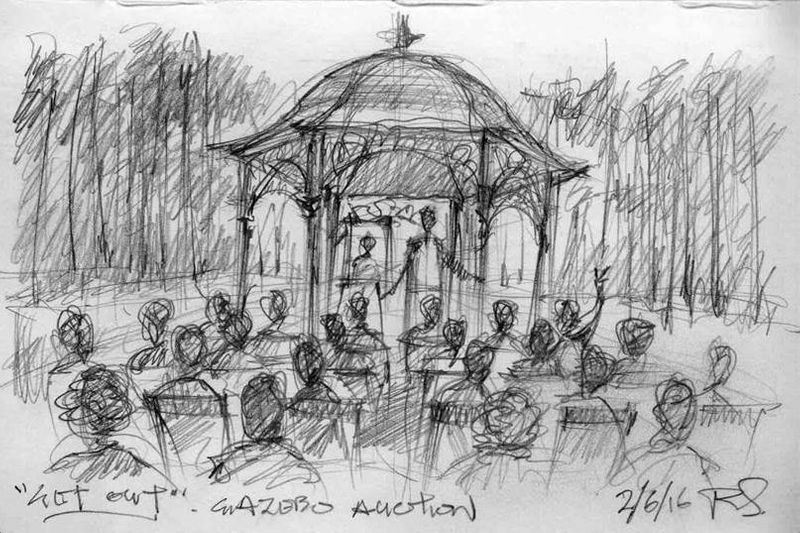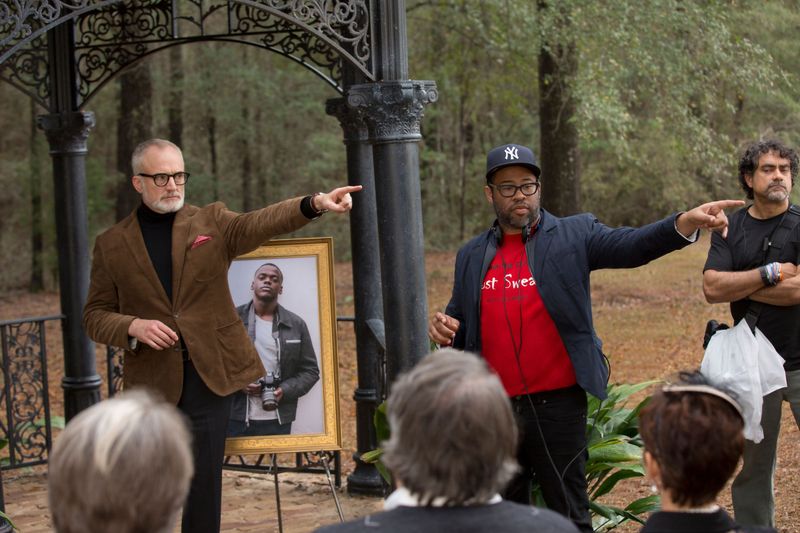Get Out was shot in just 23 days on a budget of $4.5 million, but when it opened one year ago, it quickly became clear it was not just another low-budget horror movie. There were monstrous grosses and rapturous reviews, but most important, the film instantly became a cultural phenomenon — the subject of political commentary and social-media memes. The bizarre story of a young black man lured by his white girlfriend to her family home in the country, where they plan to replace his brain with an older white person’s, it immediately introduced into the lexicon terms like “the sunken place” — as in “We’ve lost Kanye to the sunken place,” used to suggest the rapper has lost touch with his black identity. Racial inequity, and the failure of white liberals to adequately address it, proved powerful fodder for a horror narrative. A year later, as one of the most unlikely Oscar Best Picture nominees in years, Get Out is being taught in courses on racism and Afrofuturism. It began as an insight in the brain of creator Jordan Peele during the 2008 primary fight between Obama and Hillary Clinton and premiered at Sundance within a week of Donald Trump’s inauguration. This is the story of how Get Out got out.
Jordan Peele (writer and director): I had never seen the uncomfortableness of being the only black guy in a room played in a film. That notion is a perfect state for a protagonist of a horror film to be in, to question his own sanity. Rosemary’s Baby and The Stepford Wives were movies that did with gender what I wanted to do with race. And then, [once I] decided that I wanted to bite off the difficult task of making a film about race, that was a scary notion. If you fail at that, you’ve really failed.
The connection to Barack and Hillary was that for the first time, I was looking at gender and race as two parallel civil-rights movements that you could go crazy with. It almost felt like, “Who has been waiting long enough? Is it the woman?” All boiled down. Racism and sexism were seen as two parallel problems. So I thought if you could make a movie as entertaining as Rosemary’s Baby and The Stepford Wives, which have what should be an equally offensive notion — that men are going to conspire against women — you could do it with race.
Sean McKittrick (producer for QC Entertainment): It was a response to the Obama era’s post-racial-era lie. There are some aspects of the story, or scenes, that evolved because it was starting to reveal how the country was devolving — Jordan started this process before Trayvon Martin.
Lil Rel Howery (Rod the TSA agent): I can almost go back to the time when Jordan told me about it. It was at a party that Steven Spielberg throws every year. The way he was talking about it, I knew, This is not going to be a gory horror [movie]. He’s turning racism, which is already scary, into a horror! I was like, “That’s brilliant!” During the 2008 primaries, people were acting as though racism just went away, and that’s where Get Out comes from. Once I read the script, I was like, “They’re gonna let you do this? This is crazy!”
Peele: I was trying to figure out what genre this movie was, and horror didn’t quite do it. Psychological thriller didn’t do it, and so I thought, Social thriller. The bad guy is society — these things that are innate in all of us, and provide good things, but ultimately prove that humans are always going to be barbaric, to an extent. I think I coined the term social thriller, but I definitely didn’t invent it.
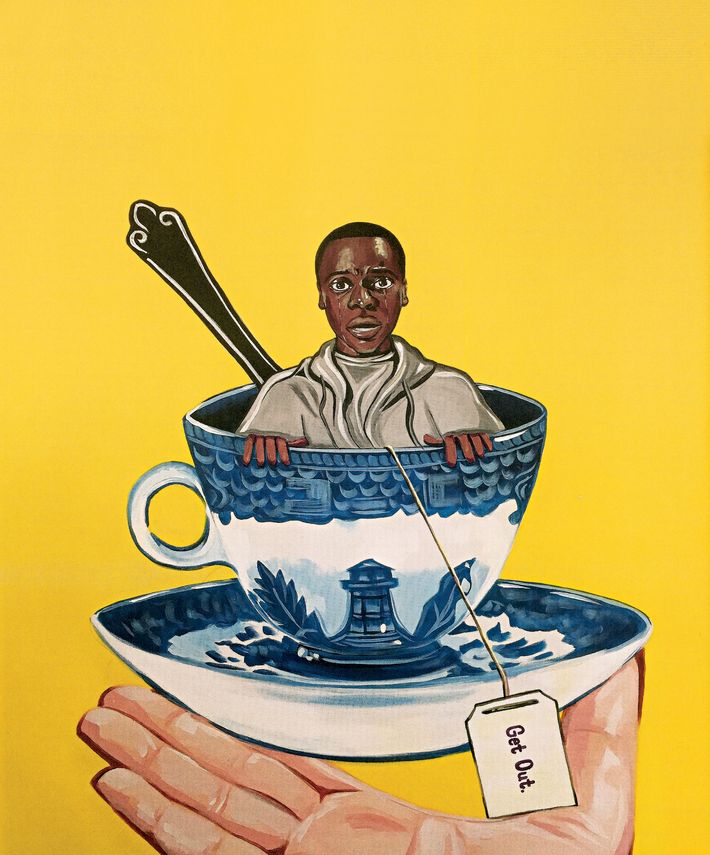
➞ Peele started talking about his idea with McKittrick in the summer of 2013. Jason Blum, head of Blumhouse Productions, the indie studio behind the Purge movies, got involved as soon as he heard about it.
McKittrick: I was shooting a movie with Keegan-Michael Key. He said, “You gotta meet Jordan, he’s a horror fanatic and he has all these ideas.” Jordan and I met for coffee in New Orleans. He said, “Here’s one you’ll never want to make,” and he pitched me the whole story. I’d never seen that movie before. It fascinated me. So I said right at the table, “Okay, I’m going to buy this pitch and pay you to write it.” I think he was a little shocked.
Peele: I got a [script] draft done in two months. There were years before that of just conceiving of the movie. By the time I sat down and actually started writing, I already knew every scene. Halfway through writing it, I realized that I had to direct it. I think I got up to the party scene, and I was like, Who else is going to do this? I have seen so few horror movies where a black person has been given the director’s chair that I realized, Why not me? I know this thing.
Jason Blum (CEO of Blumhouse Productions): I found out about it in two ways. First, Scoop Wasserstein loved the script and said I should look at it, and also an assistant heard Jordan say during an interview that he had a horror movie.
When I hear “first-time director,” I think, Twenty-five year old, made a terrific short film at Sundance and she has got her first feature script and she’s gonna make it for $2 million, indie-movie style. Jordan was already a showrunner, which I think is better experience for directing a movie than anything else. He spoke incredibly persuasively about the movie and how he was going to direct it. He was super-clear, and he was inspiring. We never looked back. All our movies are made for $5 million or less, and the agreement walking in the door with the filmmakers is that Blumhouse doesn’t take a fee and no one else does either. Nobody makes money out of the budget, they make money if the movie makes money.
➞ Daniel Kaluuya and Allison Williams read the script in late 2015 and signed on; other cast members soon followed. Shooting began in L.A. in February 2016 but shortly thereafter moved to Fairhope, Alabama — Trump country — after missing out on a California tax rebate. Much of the cast lived together in a spooky hotel, spending their days on set and nights hanging out at Williams’s rented house, which became a base camp. That bonding experience helped the actors nail complex scenes quickly.
Peele: I had seen the Black Mirror episode, “Fifteen Million Merits,” where Daniel basically was the British version of Chris. I needed someone who could be the subdued, patient, sensitive character, and I also needed the primal, passionate explosion at the end.
Daniel Kaluuya (Chris): I read it and was like, “Holy shit, man! Are you allowed to say this? Are we gonna get in trouble? This is fucking epic and unapologetic!”
Peele: A lot of this movie for me was subverting what the audience expects. My feeling about the casting of Allison Williams is that you’d expect her to be in a film where she’s the ingénue.
Allison Williams (Rose, Chris’s girlfriend): Jordan told me that he had always pictured me as Rose because Peter Pan or Marnie would make it easier for people to trust me. I was looking for a role that would weaponize everything that people take for granted about me. So I instantly signed on to it.
Kaluuya: Jordan said that he felt similar to Chris. I think Jordan’s a watcher, an observer — look at his work. He spoke to me about his experiences and the responsibility of coming from a single-parent household and what that does to you as a young boy and man. Chris has internalized his grief as blame. He feels guilt and shame for what he didn’t do for his mom. This film is a lot about letting go of grief, and wrestling with that, and not feeling you have to have the exterior of being Mr. Cool.
Howery: The first thing they shot was the airport scene in L.A., and it was just me. My hair person at the time, I don’t know what he thought we was shooting, but he had no clippers or anything! I was like, “Hot irons? Who do you think is shooting this? Rick James? Man, I’m the only person on the call sheet!” I couldn’t get a fresh cut for my first big motion picture, man.
Beatriz Sequeira (co-producer): When we first got to Alabama, everything was rushed. We had to find the right location, because in a weird way the house is the movie. Jordan had seen a house that was two hours from anywhere in the world, so it was just not feasible. Another house was great for the inside but not great for the outside, and another one was great for the outside but not great for the inside. For a while, we were going to use those two and then we decided we couldn’t be in two different locations. So we went back to the house you see in the movie and Jordan said he could make it work.
McKittrick: The overwhelming majority of us stayed at an old, seemingly haunted, beautiful hotel in Fairhope, right on the water, that used to be, of all places, a Confederate hospital. Most nights, we were over at Allison’s because she was always cooking and putting food together.
Williams: I found a place in Alabama that had a lot of land. And then it became the place where everyone would come hang out by the fire pit. We all got so much closer as a result, because at nights and on weekends we all hung out with each other, whereas if we’d been in L.A., it would have been more like a job rather than a life.
Peele: I went to Alabama with my own stereotypes and preconceived notions about getting chased out. There’s definitely a feeling that you’re in Trump country. But I have to say, the stereotypes were proved wrong. People were very sweet, very open, and there’s a lot of film lovers there who are very intelligent. Ultimately, I loved Alabama.
Kaluuya: [There were] a lot of Confederate flags. It was weird because it was in the middle of the election when we filmed. I didn’t get to see a ton of the town. We had too much racism to talk about to see the racism around us.
Betty Gabriel (Georgina the housekeeper): There were some things that, at the time, I found more comical than scary. A lot of the houses had Trump signs. There was a lot of support for him in that cute little town.
Marcus Henderson (Walter the groundskeeper): At four o’clock every day, they shot off cannons.
Howery: The hotel felt like it was run by ghosts, you know? Daniel used to run at night, which I thought was crazy. When I first got there, I was coming from dinner and I saw Daniel in this hoodie and shorts. He kind of creeped me out. I was like, “Man, what are you doing?” “I’m just running.” “At night? Around here? You’re crazy! What are you trying to do, get into character or something?”
McKittrick: I had my daughter going down the hall in one of those little cart things, and all I could think of was The Shining. Those are what the older portions of the hotel are like — they’re very much the Overlook.
Gregory Plotkin (editor): What Jordan did in a smart way was give every actor their own solo. Caleb Landry Jones had it in the dinner sequence, Bradley Whitford had the iced-tea sequence, Catherine Keener had the hypnosis sequence. They all had these moments to show you who they really were. It built the tension in a great way.
Bradley Whitford (Dean, Rose’s father): I think almost everybody in the movie gets to play a couple of things. There’s never just one thing going on. Dean was a delicious opportunity for self-parody. I mean, I say lines like, “I would have voted for Obama for a third term.” In my defense, I say them to white people as often as I say them to African-Americans. I didn’t realize how much of a laugh line that was.
Williams: I got there a few weeks early to get settled in. We went on this retreat, ran scenes, and just spent time together. We did some improv stuff as a family, and it worked out how they operated as a unit. It was fascinating. And then to contextualize it we watched one of the Republican debates. There was something wrong with the TV, all their skin was blue, so it was perfect.
McKittrick: Any time Allison went into what we called “Ro-Ro mode,” she became “Ro-Ro,” which is the real Rose, the evil Rose. She’d have headphones in and pull her hair back tight into a ponytail and walk around like a shark roaming through the set. She wouldn’t talk to anyone, and you didn’t want to talk to her. That always cracked me up — and freaked me out a little bit.
Williams: I realized it would be more evil and eerie if we saw Rose in her natural state at the end and realize that for the rest of the movie she’s basically playing a character. A lot of our conversation was figuring out how to make her as innocent-seeming for as long as possible. I tried to layer in looks that could seem either on first viewing like she was mad at a white person for treating her boyfriend weirdly or, on a second viewing, upset at a white person for blocking her from being able to get this over with. When the cop pulls them over, that’s a scary moment for her because it could mess up her whole operation.
Then we built out two decoy arcs. One of them was this racial “wokening,” so that the audience thought she was learning about racism. The other decoy was Rose’s attempt to get Chris to open up, because he lost his mom. Both of those things come to a head at the lake when they’re talking, and she says, “All right, let’s go home.” It was complicated, but it was really fun and cerebral.
Kaluuya: You’re already seen as aggressive if you’re a young black male. You have to have a veneer of coolness. In Get Out, I felt responsible for Chris’s emotional arc, which is a pressure cooker of oppression. That final third is a release of all of it — tension, suppression, repression, and then boom! At the beginning of the movie, I understand how Chris reacts, because he understands the cost of saying something. There’s a cost for standing up for yourself if you’re black.
Williams: My instinct is that Rose is all in and this is all she knows and she really likes that she’s good at it. She is not a victim of indoctrination or Stockholm syndrome. One of my first questions to Jordan was, “If her whole family died and she survived, would she keep doing this?” and he said, “Yeah.”
McKittrick: Shooting the hypnotism scene was really astonishing. Daniel can control a tear in every take. He uses so much energy when he’s acting that he literally just goes and lies down afterward, and then goes right back into it. It was exhausting to watch.
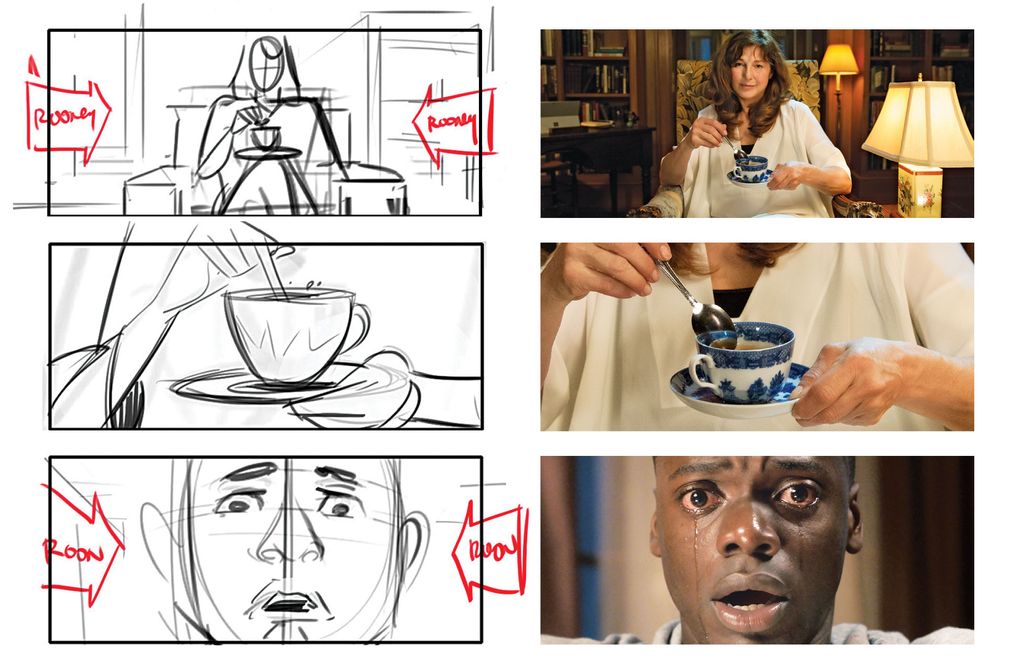
Catherine Keener (Missy, Rose’s mother): I went into the hypnotism scene before Daniel knew it had started. We pulled up two chairs facing each other, and I said something like, “Chris, I thought you were American.” Daniel went “Huh?” because he’s British. And then we went right into it because of that. Chris even says in the scene, “Wait a minute, are you doing this now?” That time was the only rehearsal we had. Daniel was so there. There was no need to keep at it.
Plotkin: As soon as I saw the dailies, I called the sound mixer and said, “I need a clean version of that teacup, so please go on set, take the teacup, and just stir the spoon around it.” It became this hypnotic sound we carried throughout. I wanted the sequence to work as a straight drama between Chris and Missy. And then, when it felt right — I think when Missy says, “What about your mother? Where were you when she died?” and he says, “I don’t want to think about that” — I cut to the teacup to show she’s turning the spoon, and then Chris acquiesces and says, “Home. Watching TV.” The teacup in that scene became a character.
Toby Oliver (cinematographer): The sunken place was quite abstract and conceptual on the page. So it was a real challenge to figure out how we make that illustration of someone’s subconscious work without a huge truckload of visual effects. I came up with the idea of shooting it with a technique called “dry for wet.” Normally that’s used for an underwater scene — I think they did a lot of it in James Cameron’s The Abyss. You shoot on a dry stage that has lots of smoke and shoot everything in slow motion, make it feel like it’s underwater. Then you have some winds to ripple anything that’s moving and give you that feel that it’s floating. But we didn’t use any smoke, because we’re not actually trying to say it was underwater. We’re saying it’s in his mind.
Gabriel: Sometimes I thought, “I don’t know if I want to play a old white woman. Where do I even start, you know?” But, as the heavy TV watcher I have been all my life, I feel like I know the white woman very well. I’ve seen that be played out so much, seen Jessica Lange, or Faye Dunaway, or Glenn Close. I’ve seen white women and seen that sort of quality. That superiority.
Henderson: I [was] a black actor playing a white man that’s in a black body and there are two different ways you can take that, to me. You could try really hard to prove to people that you’re black. Or you could make the choice I made, which was that I’m a rich white man and I can do what I’ve been doing for centuries, which is whatever I want. People can just see that I’m black, and I can still be myself. I think that’s what’s awful about Walter in general. He wasn’t trying to play into an idea of being black. He was just black because he was black. It’s really a mind-wrestle.
Gabriel: Not much is said on the page about Georgina. She brings in this carrot cake, she leaves. You see her knitting, and she leaves. So I learned how to knit. I made a carrot cake. It’s like Fairhope: It’s very quaint, and peaceful, and the act of knitting and the act of baking is very nice and you have to do it perfectly — otherwise, it won’t come out right. So I tapped into the idea that she is the embodiment of perfection in some very distorted way. Then I watched old horror movies and I listened to things, like a podcast about Martin Pistorius, a South African man who lost complete control of his body, and was in a vegetative state, or so everyone thought, for more than 12 years. But he was responsive and still there, present. They could see it in his eyes.
Howery: There wasn’t a lot of gore and stuff. The camera was straight on our faces. Those scares came from a look, like the scene where Georgina said, “No, no, no!” It’s the look she gave, as if she’s fighting back and forth between the grandmother and the young lady. You can see it in her eyes.
Gabriel: The scene with Daniel where Georgina unplugs his phone came together that day. The cinematographer was saying, “Well, you just had a scene where people were standing and talking. So this next scene should be different.” And Jordan and I had the idea to just walk in like bridal position, coming down the aisle, step, sidestep. And we did the extreme close-up, and I’m looking at Daniel, looking at me and freaked out by me, and it kind of escalated.
Peele: The scene that was the hardest to get across was the keys scene. We made this great reveal with Rose upstairs when Chris is looking through the photographs [of black men Rose has lured to the house before], and then this scene was basically three minutes leading us toward a second reveal with Rose and the keys. In four minutes, we’re doing the same reveal twice. It was hard to describe how it wouldn’t be this massive redundancy. And that scene takes place in this nebulous zone where all the characters know what’s going on, but the tension hasn’t broken. That’s the day I felt like I kind of “became” a director for real because ultimately the cast trusted me and it really, really worked.
Williams: That scene took so much conversation just to figure out what we wanted people to be feeling and when. While we were filming it, Jordan would say, “Good, do one where the whole time you have no idea what’s happening,” “Do one where you know you’re just playing with him,” and he’d find little moments from each of those to create the final vibe. The one we settled on was where she has no idea [that Chris knows about the photos], and the impetus behind it was that she gets this perverse pleasure from playing with them, leaving her closet ajar, as disgusting as it is.
Howery: I started to make up stuff in my head for Rod. I always say that Jordan wrote everything that Rod says in the script, but he’ll say, “No, Rel, you went on that rant. That was you.” I’m like, “For real?” I black out in character, and I’m just gonna talk, and I don’t know what I’m saying sometimes. A lot of it made it in!
Peele: Black audiences are obsessed with horror films but consistently frustrated with them. Part of the reason goes back to the Eddie Murphy routine about how a black family would be much different than a white family in a horror movie. There is a heightened awareness that black Americans have developed in looking out for racism and the real horrors that we’ve been subjected to for years. But even if you’re not black, it’s satisfying to see a movie where somebody at least is aware that this could go into a horror situation. With Rod, you have a guy who satisfies both worlds realistically. He sort of knows what’s up, but he’s a little over the top. It’s understandable why our lead would go, “Okay, okay, all right. Thank you. That’s all the help I need.”
Henderson: Canfield Drive, where Mike Brown got shot, is four miles from my parents’ house. My mom knew Mike Brown, we know his family, I went to school with his cousins. So when he got shot, it hit me in a whole different way because I’m watching the media profile my hometown. I had to watch Bill O’Reilly talk about Ferguson, and he doesn’t know shit about Ferguson. It was so crazy, and the thing about Get Out that resonated the most with me was going through this world as a black body that people looked at through envious lenses. For instance, in the dinner scene when Jeremy is talking about Chris’s shoulders and what he could do if he just trained a little bit — “You could be a fucking beast.” How many times have I heard that from people when they find out that I don’t go to the gym? If you want to trade places to see what it’s like, by all means, go ahead.
➞ Originally, the movie ended with a police car turning up at the house, followed by a scene of Rod visiting Chris in jail. After test screenings, Peele decided to shoot a different ending in which the car turned out to be a TSA vehicle driven by Rod, coming to his friend’s rescue.
Kaluuya: The last ten minutes were tough because I was covered in blood, and the people who owned the house refused to let me in because of that. That was a night shoot, I was exhausted, I was running around, I had a bag leg, bad arm, and I was just standing there. And then they gave me this van that had a plastic seat in it! I just felt like a leper.
McKittrick: We tested the movie with the original “sad truth” ending where, when the cop shows up, it’s an actual cop and Chris goes to jail. The audience was absolutely loving it, and then it was like we punched everybody in the gut. You could feel the air being sucked out of the room. The country was different. We weren’t in the Obama era, we were in this new world where all the racism crept out from under the rocks again. It was always an ending that we debated back and forth, so we decided to go back and shoot the pieces for the other ending where Chris wins.
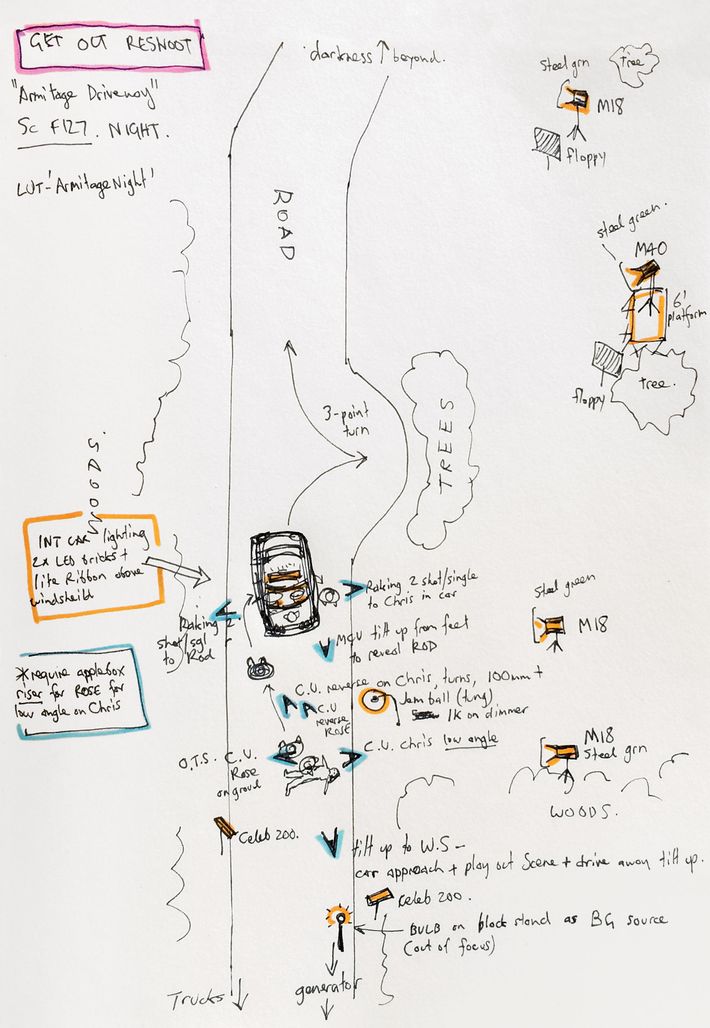
Henderson: I remember when they gave the verdict that Darren Wilson wouldn’t be indicted, and you felt defeated. Like, “Man! Can we catch a break?” What the original ending said was, “No, you can’t catch a break,” because that’s our reality. But the new ending gave us a break, and I think that’s why we enjoyed it so much, because we want it so badly. The similarities of the narrative are so parallel to what actually happened in Ferguson. When I have conversations with people about it, we talk about the importance of watching that black body get away to tell his story. Because you know who didn’t get to tell their own story? Trayvon Martin. Mike Brown. Philando Castile.
Kaluuya: I love the original ending. It was great because of what it said about life — there’s this black guy who’s really cool and went through this trauma, got through all this racism, and in fighting for himself he gets incarcerated. That really resonated with me, because it showed me how unfair the system is. However, in hindsight, you still have that with the police lights, and Rod saves him through the black brotherhood — and also, Chris has a life, you know? He has to go out there even after he’s experienced all this racism, and people expect you to see the world in the same way when they haven’t experienced something like that. I thought that was really honest.
Whitford: The original ending was making a statement that I think Jordan felt a white audience might be able to dismiss about mass incarceration. The ending he ended up with does a brilliant thing, because when Chris is strangling Rose in the driveway, you see the red police lights, and then you see the door open and it says “Airport” and it’s a huge laugh, and everybody has that same laugh and release. You understand from Chris’s POV that if the cops come, he’s a dead man. That is absolutely brilliant, non-lecturing storytelling.
Peele: I think my improv training just put me in this mind frame of, with each problem, there’s not one solution, there’s not two solutions, there’s an infinite amount of great solutions. That includes the ending. When I realized the original, downer ending wasn’t working, I didn’t freak out. I looked at it as an opportunity to come up with a better ending.
➞ Get Out was Sundance 2017’s midnight secret premiere, and word of mouth was strong — even Malia Obama showed up.
McKittrick: Nobody was really sure how widely the movie should be released. So Universal cut together a trailer and put it out during the BET Awards. The response was astronomical — it got something like 25 million views in 12 hours. That’s when everybody knew, “Okay, we really have something here.” The reception to it from Sundance critically was amazing. Couple all those things together and it made Universal more confident to be bolder in their marketing campaign.
Blum: Everyone hoped we’d open in high teens. I was hoping for low 20s: 20, 22, 23. The first weekend, we took $33 million and you usually do a two-and-change multiple. Take an ordinary horror movie that opens to 28 — that usually gets up to $65 million, $70 million. That’s good, but it’s not $180 million. It’s not mind-blowing. What was mind-blowing was the second weekend. Usually it drops 60 percent. Get Out dropped 20 percent. That was the celebratory part of the box office. But I think there was probably more celebration at “99 percent fresh” on Rotten Tomatoes.
Peele: When I was making the movie, I was putting enough Easter eggs and layers in there that I felt like someday — and I’d say this to people — “in 20 years, they’re gonna look back and see all these things.” I did not expect the movie to be taken as seriously out of the gate, and for people to scrutinize it and see it as many times as they did right away. So I think the thing that really propelled this into such a pleasing success was the fact that people saw it over and over and over again.
Williams: Seeing it in a theater with an audience for the first time was unbelievable, because everything Jordan wanted to make the audience think was happening. Even some of the things he told us people would say out loud were happening.
Kaluuya: Sometimes people will want to touch my face. They want to see my crying face. But also, people will just talk to me about racism. I’m a bit of a walking therapy session! They can’t believe there’s a film out there that is how they think. They’re like, “I’ve had that happen with my girlfriend/boyfriend. I’ve had that when I’m in this environment. I don’t feel comfortable. You made me feel like I’m not crazy.” Because we identified all the microaggressions.
Whitford: The one scene that really got disturbing for me was the auction moment. That really felt queasy. People have come up to me and asked me to stand behind them and pretend I’m auctioning them, which is … [laughs]. I was at a strip mall in L.A. and I didn’t have any cash, and someone said there was a cash machine in the barbershop. So I went into the barbershop and I opened the door and there were 15 African-American guys getting cut — and they all screamed.
Henderson: The Get Out Challenge meme was inspired by my role. I got messages every day for three months: “Did you see this one? And did you see this one? Did you see this new one?” There were people running up to me and they were doing it to my face.
Tiffany Vazquez (content manager at Giphy, an online database of animated GIF files): It just became instantly integrated into our everyday conversation. A lot of these terms were so relevant to what was happening politically last year and Jordan would tweet a picture or a GIF or say that someone was in “the sunken place” and everyone got it.
Jasmyn Lawson (culture editor at Giphy): The best part of black Twitter to me is that we talk about our oppression, and what the movie is symbolizing is being in spaces where people want everything from you — your talent, your smartness, your looks, your appeal — but don’t value all of you. So that was a larger, deeper conversation, but of course we always love to put a joke or a spin on it and find humor in the oppression, and I think the GIFs allowed us to do that.
Vazquez: Jordan Peele tweeted Betty’s Twitter handle with “Here, follow her before she follows you,” and a GIF of her just staring out of the window. He would also use the “No, no, no” GIF. That’s definitely the best “No” GIF of last year, but it might be one of the best “No” GIFs in history. It’s perfectly performed.
Gabriel: Honestly, I was a little weirded out by it. Of course, it’s extremely flattering, I guess. I’m trending. Yay. But it was a condensing of something that’s quite horrific and tragic.
Tananarive Due (lecturer in the Department of African-American Studies at UCLA): I was tweeting about building the class [Sunken Place: Racism, Survival, and Black Horror Aesthetic] and how excited I was over the summer, and a reporter did a story about it. The same day, I got a message from Jordan Peele, saying “it would be funny if I surprised them.” A few weeks later, I showed the students the clip when Rose makes it clear that she’s in on the plot — she’s holding up the keys. While they’re all talking about the scene, we snuck Jordan into the back row. The lights came up and I said, “What do you think the director was trying to say about the coveting of black bodies?” And in the back row he says, “Uh, I have a question,” and stood up. The class went crazy.
John Jennings (professor at University of California, Riverside): After the film, I immediately went to my office and wrote a syllabus. It flowed out of me. I think there’s going to be a before Get Out and an after Get Out.
Due: Peele told my class that when he was writing the scene with the sunken place, he realized that it represented the prison-industrial system. He saw the metaphor of black bodies being abducted and thrown into holes and he said he started crying. He wasn’t used to being that person who looked at these issues systemically.
Blum: My relationship to the racism that exists in me and in the world fundamentally changed. The movie is about racism that exists in liberal, elite America. The first thing a liberal or a Democrat says is, “We’re anti-racist. That’s a big thing.” The truth is, there’s a lot of racism that exists in that thinking, and inside me, that I wasn’t aware of. There are things that I would have done two years ago that I would not do now as a result of making the movie. It’s impossible for me not to imagine that many, many people have had the same experience.
Kaluuya: It allows you to exhale. It makes you feel less crazy. That’s what that film did for me. And if you’re carrying that tension or holding your breath, you understand that he’s created a cinematic language for what happens when you’re in those situations. People in my life say “sunken place,” they now have a word that describes everything that they’ve felt. Before the film, you know it, but you don’t have the words for it.
*A version of this article appears in the February 19, 2018, issue of New York Magazine. Subscribe Now!
